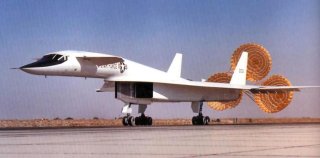Why The Sukhoi T-60S Was A Technical Disaster
The Sukhoi T-60S project grew out of the older T-4 concept.
Here's What to Remember: A T-60S prototype was slated to undergo flight tests in 1996, with the bomber scheduled to enter service in 2003. The collapse of the Soviet Union put a swift end to these plans, with the project facing outright cancellation in the early 1990s. Still, there were some signs to suggest that the T-60S project was headed for a technical disaster irrespective of the Soviet collapse.
One of the Soviet Union’s most ambitious postwar aircraft projects, the ill-fated T-60S bomber, offers a glimpse of the modern Russian bomber force that could have been.
In the mid-1980s, the Soviet military launched a procurement search for a new intermediate-range bomber to phase out its slew of aging aircraft. The early 1970’s Su-24 attack aircraft and Tu-22M strategic bomber were most in need of a replacement, but Soviet authorities were also interested in laying long-term plans for a versatile, modernized bomber platform to succeed the newer Tu-22M3.
The Sukhoi T-60S project grew out of the older T-4 concept, a proposed Soviet reply to the XB-70 Valkyrie that never made it past the prototype stage. The T-60S project was shrouded in secrecy since its inception, and many of the details surrounding its rocky development remain classified to this day. Still, it is widely believed that the T-60S is a variable geometry swing aircraft, equipped with two-dimensional thrust vectoring nozzles. The latter change is meant to mitigate control instability at high speeds, one of the chief problems confronting the prior T-4MS program. Capable of supercruising at Mach 2 and boasting a takeoff weight of roughly ninety tons, the T-60S is significantly lighter and marginally faster than the Tu-22M3. There were reports that the T-60S was to utilize new stealth features for enhanced deep penetration capabilities, though the precise nature of these efforts remains unclear.
Boasting a combat range of 2,200 km, the T-60S was believed to carry a payload of up to 20,000 kg. The bomber’s armaments included cruise missiles from the Kh-101 and Kh-55/65 series, a large catalog of guided munitions, and conventional as well as nuclear unguided bombs—this makes the T-60S similar to the Tu-22M3 in armament configuration, albeit the latter boasts a noticeably larger payload of 24,000 kg.
A T-60S prototype was slated to undergo flight tests in 1996, with the bomber scheduled to enter service in 2003. The collapse of the Soviet Union put a swift end to these plans, with the project facing outright cancellation in the early 1990s. Still, there were some signs to suggest that the T-60S project was headed for a technical disaster irrespective of the Soviet collapse. Sukhoi engineers apparently struggled to implement some of the T-60S’ unique design decisions, including controversial changes made to the wing construction.
In the end, the T-60S’ well-rounded performance and robust combat capabilities were not worth the risks stemming from its more eccentric construction choices. The Kremlin decided, not without sound reason, that the Su-34 fighter-bomber was a safer bet. The Su-34 has gone on to become a staple of Russia’s strike fighter forces, with as many as 120 models currently in service and several waves of modernization packages planned in coming years. Likewise, the upcoming Tu-22M3M—one of the handful of Russian aircraft confirmed to be compatible with the new, nuclear-capable Mach 10-speed Kh-47 “Kinzhal” missile—is slated to enter service this year.
Mark Episkopos is a national security reporter for The National Interest. This article first appeared earlier this year.
Image: TNI.

